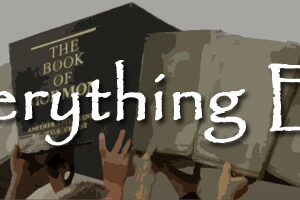Zeniff records some of the Book of Mormon seeds:
Mosiah 9:9
And we began to till the ground, yea, even with all manner of seeds, with seeds of corn, and of wheat, and of barley, and with neas, and with sheum, and with seeds of all manner of fruits; and we did begin to multiply and prosper in the land.
From wikipedia:
Grains are mentioned twenty-eight times in the Book of Mormon, including barley and wheat. The introduction of domesticated modern barley and wheat to the New World was made by Europeans sometime after 1492, many centuries after the time in which the Book of Mormon is set.
Taken from a Book of Mormon critic’s viewpoint:
When Joseph Smith concocted the Book of Mormon, he just assumed that the ancient Amerindians had the same kind of agriculture as that which he knew in upstate New York. Consequently, he had his ancient characters growing wheat, barley, corn, and flax, and planting vineyards for wine, and being able to understand the symbolism of the olive and trees. Now, of course, Smith was right about the corn — that is, maize. But is there anyone of Smith’s day who had not heard of “Indian corn,” or did not know that corn had come from the Indians? What Smith did not know, however, was that corn was but one of three staple crops raised by the Indians of Central America — the region in which the discovery of ruined civilizations had triggered enormous amounts of speculation in the time of Smith’s youth. The other two major crops were squash and beans. These were supplemented by such things as avocados, amaranth, etc. You can search all you want in the Book of Mormon, but you won’t find any mention, apart from corn, of the crops actually raised in ancient America. Incidentally, we have numerous cases where these crops have been preserved in archaeological sites and are easily identifiable.
What does archaeology tell us of the presence or absence of the crops Smith claimed were the staples of ancient America? No remains of wheat or domesticated barley have ever been found. In fact, the one possible pre-Columbian specimen of barley discovered at a site in Arizona is of a species different from the species of domesticated barley allegedly brought from the Near East. And what of flax? No dice, again. Fortunately for lovers of truth, the Mormon apologists cannot simply say we haven’t been looking in the right place, or that the remains of these plants have all perished with the passage of time. The reason for our good fortune is the fact that these domestic plants are all flowering plants. As such, they produce pollen — in great abundance. If the so-called Mormonic civilizations had been growing these crops for even a few decades — let alone the thousands of years allegedly chronicled by the Book of Mormon — every soil coring taken in Central America should show traces of wheat, barley, and flax pollen. Pollen is one of the most indestructible natural objects known.
An example of the type of research that shows Book of Mormon agriculture to be nineteenth century phantasy is David J. Rue’s 1987 paper in Nature titled “Early Agriculture and Early Postclassic Maya Occupation in Western Honduras.” By studying soil corings from Lake Yojoa and Petapida Swamp, both in western Honduras, Rue was able to reconstruct the agricultural history of the area from a time 4770 years before the present up to modem times. He could tell from pollen when the region was forested, when the forest was cut and burned for agriculture, what crops were grown and for how long. Although he found clear records of pollen from corn (maize) and amaranth — two Amerindian staples — he makes no mention of wheat, barley, or flax pollen. Perhaps the Mormon Church would like to pay him to go through his cores again, looking more carefully for the mythical motes that should be in them if the Book of Mormon be true!
There was no wheat or barley, and we have no idea what neas or sheum are. Again, if wheat or barley was not wheat or barley, then Joseph Smith, Jr would have used some other name like neas or sheum.



